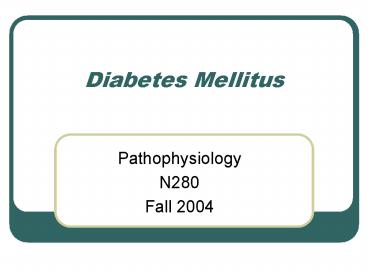Diabetes Mellitus - PowerPoint PPT Presentation
1 / 21
Title:
Diabetes Mellitus
Description:
A syndrome characterized by chronic hyperglycemia and other disturbances of ... tremor, anxiety, tachycardia, palpitations, diaphoresis, headache, dizziness, ... – PowerPoint PPT presentation
Number of Views:102
Avg rating:3.0/5.0
Title: Diabetes Mellitus
1
Diabetes Mellitus
- Pathophysiology
- N280
- Fall 2004
2
Diabetes Mellitus
- A syndrome characterized by chronic hyperglycemia
and other disturbances of carbohydrate, protein,
and fat metabolism - Diagnosed by clinical manifestations, fasting
plasma glucose levels, and glucose tolerance
tests - Goals of therapy are to maintain euglycemia,
avoid hypoglycemia, and prevent severe
cardiovascular and neurologic complications
3
American Diabetes Association (ADA)
- Classifies four categories of diabetes mellitus
- Type 1 (absolute insulin deficiency)
- Type 2 (insulin resistance with an insulin
secretory deficit) - Other specific types
- Gestational diabetes
- Page 487, table 18-3
4
Type 1 diabetes mellitus
- Insulin dependent (IDDM)
- Impaired secretion of insulin by beta cells
- A result of autoimmune destruction of beta cells
or loss of beta cells due to viral infection - Abrupt onset of symptoms with a long pre-clinical
period - Common childhood disease, onset can be any age
but is common around puberty
5
Type 1 diabetes mellitus
- Clinical Manifestations
- Affects the metabolism of fat, protein, and
carbohydrates - Acute onset of polyuria, polydipsia, and
polyphagia with weight loss and wide fluctuations
in blood glucose levels - Ketoacidosis caused by increased metabolism of
fats and proteins resulting in high levels of
circulating ketonespH drops (metabolic
acidosis)blow off acetone (sweet, fruity
breath)--coma
6
Type 1 diabetes mellitus
- Evaluation and Treatment
- Presence of above symptoms combined with fasting
and postprandial hyperglycemia - Individual management however all require
insulin, meal planning, and exercise - Hemoglobin A1c to monitor effectiveness of
treatment and prevent complications
7
Type 2 diabetes mellitus
- Non-insulin dependent diabetes (NIDDM)
- Cause unknown
- Resistance to metabolic affects of insulin in
target cells - Generally occurs in those over 40 yo but can
occur in children - Usually associated with obesity
8
Type 2 diabetes mellitus
- Risk factors
- Obesity, increased body mass index, family
history of type 2 diabetes, member of an ethnic
minority, puberty, female gender, and metabolic
syndrome - Clinical Manifestations
- Overweight, hyperlipidemia
- Onset is slow and insidious
- Pruritus, recurrent infections, visual changes
and paresthesias
9
Type 2 diabetes mellitus
- Evaluation and Treatment
- Underdiagnosed
- Goal of treatment is euglycemia and correction of
metabolic disorders - Dietary measures, restricting caloric intake and
both cholesterol and saturated fats - Hyperglycemic oral medication
- Exercise is essential
10
Gestational Diabetes
- Glucose intolerance during pregnancy
- Risk factors
- Glycosuria, family history of diabetes, obesity,
high maternal age, parity of 5 or more, a
previous complicated pregnancy
11
Acute Complications of Diabetes Mellitus
- Hypoglycemia
- Related to insulin treatment
- Symptoms
- Pallor, tremor, anxiety, tachycardia,
palpitations, diaphoresis, headache, dizziness,
irritability, fatigue, poor judgment, confusion,
visual disturbances, hunger, seizures, and coma - Treatment to provide immediate replacement of
glucose
12
Acute Complications of Diabetes Mellitus
- Diabetic Ketoacidosis (DKA)
- Deficiency of insulin and an increase in insulin
counterregulatory hormones (catecholamines,
cortisol, glucagon, growth hormone) - Increased glucose production in liver, peripheral
glucose usage decrease - Fat is mobilized, ketogenesis is stimulated
13
Acute Complication of Diabetes Mellitus
- Hyperosmolar hyperglycemic nonketotic syndrome
- Uncommon complication of type 2 diabetes
- Poor glucose control resulting in high levels of
serum glucose (gt500 mg/dl) - High serum osmotic pressures lead to severe
dehydration, low blood volume, and low perfusion
pressures
14
Acute Complications of Diabetes Mellitus
- The Somogyi Effect
- Hypoglycemia followed by rebound hyperglycemia
- Rise in glucose related to counterregulatory
hormones (epinephrine, GH, corticosteroids
stimulated by hypoglycemia) - The Dawn Phenomenon
- Early morning rise in blood glucose concentration
with no hypoglycemia during the night - Related to nocturnal levels of GH
15
Chronic Complications of Diabetes Mellitus
- Hyperglycemia and nonenzymatic glycosylation
- The reversible attachment of glucose to proteins,
lipids, and nucleic acids without action of
enzymes - Advanced glycosylation end-products (AGE) are
products of above binding AGEs have properties
that may cause tissue injury or pathologic
conditions associated with diabetes
16
Chronic Complications of Diabetes Mellitus
- Hyperglycemia and the polyol pathway
- Glucose metabolism used by tissues that do not
require insulin for glucose transport (kidney,
RBC, blood vessels, eye lens, and nerves) - Glucose is converted to sorbitol, which is then
converted to fructose which increases
intracellular osmotic pressure and attracts water
into cell, leading to cell injury
17
Chronic Complications of Diabetes Mellitus
- Protein Kinase C
- Extracellular enzyme activated by hyperglycemia
- Causes insulin resistance, vascular cell
proliferation, enhanced contractility and
increased permeability (contributing to micro and
macrovascular, and neurologic complications of
diabetes)
18
Chronic Complications of Diabetes Mellitus
- Diabetic neuopathies
- Common complication of diabetes
- Advanced glycosylation end-products and increased
formation of polyols contribute to nerve
degeneration and delayed conduction - Microvascular disease
- Decreased tissue perfusion and hypoxia result
from thickening of the capillary basement
membrane, endothelial hyperplasia, thrombosis,
and pericyte degeneration - Diabetic retinopathy, diabetic nephropathy
19
Chronic Complications of Diabetes Mellitus
- Macrovascular disease
- More common in type 2 diabetes
- Atherosclerosis
- Coronary artery disease
- Stroke
- Peripheral vascular disease
- Infection
- Five reasons for increased risk of infection
- The senses, hypoxia, pathogens, blood supply, WBC
20
Chronic Complications of Diabetes Mellitus
- The senses
- Impaired vision (retinal changes) and impaired
touch (neuropathy) - Hypoxia
- Skin integrity compromised
- Glycosylated hemoglobin impedes release of oxygen
to tissues - Pathogens
- Increased blood sugar provides an excellent
source of energy for some pathogens to proliferate
21
Chronic Complications of Diabetes Mellitus
- Blood supply
- Decreased blood supply due to vascular changes
decreases the supply of WBC to affected tissues - White cells
- Impaired function
- Abnormal chemotaxis, defective phagocytosis































